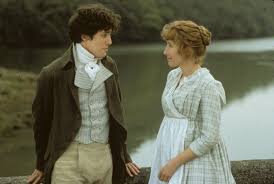In a guest post on Jane Friedman’s blog, Robin Henry shares lessons on story structure from Jane Austen’s Sense and Sensibility. “In addition to being in the vanguard of writers who were developing new styles for telling stories, Austen also gave her plots shape, while many of her contemporaries were still writing episodic adventures steeped in coincidence and deus ex machina.”
Henry identifies the six plot points that provide structure for Sense and Sensibility: Stasis, Inciting Incident, Complications, Midpoint, Crisis, Climax, and Resolution. These aren’t all the plot elements, but do represent the major events and decision points.
- Status. Also referred to as the status quo or story world stage, stasis represents life before the inciting incident. In chapter 1, Austen introduces her characters and their central conflict. Without money, women have no power and male relatives control their choices. Almost immediately, Fanny Dashwood, wife of the heir to the Dashwood estate, arrives to create conflict.
- Inciting Incident. In chapter 4, the Dashwoods decide to relocate after Fanny makes them feel unwelcome in their family home. In the. Barton Cottage in Devon, the Dashwoods will meet the other important characters of the novel.
- Complications and Midpoint. In chapter 22, Elinor experiences a setback when she learns that Edward is secretly engaged. Meanwhile, Marianne is pursuing the eligible Willoughby. In chapter 25, the exact midpoint, Elinor and Marianne travel to London, providing a change of setting and situation. At this moment, the arcs of the two main characters are crossing, as one is on the way up and the other on the way down.
- Crisis. Between chapters 28 and 34, both Elinor and Marianne experience crises in London. Marianne’s crisis happens openly, when Willoughby publicly jilts her at a dance. In contrast, Elinor’s crisis is private, when Edward refuses to break off his loveless engagement following an intimate dinner party.
- Climax. Following continuing complications and revelations, the sisters return home. Marianne falls ill, another public crisis, leading to the climax of her story: Capt. Brandon’s declaration of love. Again in contrast, Elinor’s story resolves in private, when she learns that Edward was jilted by his fiancee after he was disinherited.
- Resolution. Edward and Elinor are soon married, followed by Marianne and Capt. Brandon.
It can be argued that Austin created the modern novel structure. “The break into Act II happens in chapter 5, when the Dashwood ladies move to Barton Cottage, 10% into the novel,” Henry notes. “At chapter 45, 10% from the end of the novel, Elinor and Marianne are back at Barton Cottage after their adventures for the climax and resolution, arguably Act III.”
Novels don’t have to follow this exact structure, of course, but there is a clear structure here, with turning points, complications, raised stakes, and crises, as well as balance. Acts I and III mirror each other, and big decisions happen at the midpoint. The other crises and complications are spaced to allow the reader to absorb the changes and rising stakes as the finale looms.












